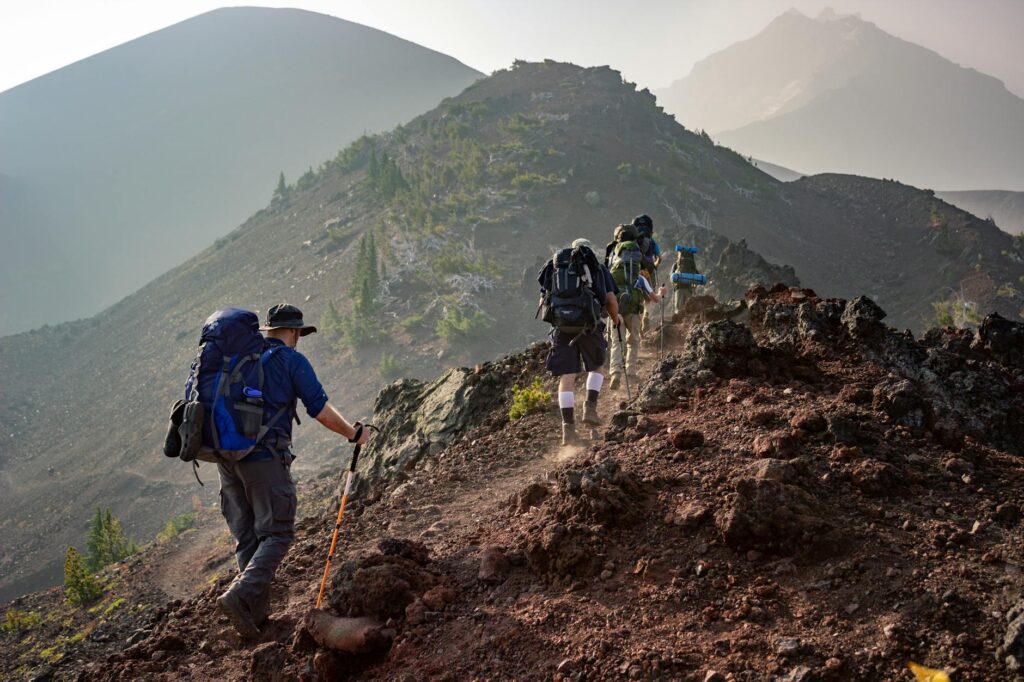1. Introduction
Preparing for trails is essential to avoid unforeseen events and ensure a positive experience. It's not enough to just choose a beautiful destination and go there, is it? It is necessary to plan every detail, from transportation to food, including navigation and orientation. By following these safety rules and recommendations, you will avoid accidents, injuries, losses and damage to nature. Furthermore, you contribute to the responsible practice of ecotourism, which aims to respect and conserve natural resources.
Therefore, in this article, we will show you the complete guide for a safe journey in nature, from choosing essential equipment to communicating in case of emergencies. Follow along!
II. Essential Equipment
To go on a trail safely, it is essential to have the appropriate equipment to face the weather conditions, the terrain and any possible emergencies that may arise. In this chapter, we will cover the main items that you should take in your backpack to ensure a peaceful and comfortable journey in nature.
A. Appropriate clothing
Clothing is one of the most important aspects of safety on the trail, as it directly influences your thermal comfort, mobility and protection against external factors. Therefore, it is essential to choose the right clothes for each type of trail, taking into account temperature, humidity, wind and sun exposure.
1. Optimal layers and materials
- First layer (base): Keeps the body dry and thermally regulated. Avoid cotton.
- Second (intermediate) layer: Provide thermal insulation. Use fleece, wool or goose down.
- Third layer (outer): Protects against wind, rain and snow. Waterproof and breathable material such as Gore-Tex.
2. Importance of appropriate footwear
- Type of terrain: Choose from running shoes for flat terrain or trail boots for uneven terrain.
- Backpack weight: More robust shoes for heavy loads.
- Foot size and shape: Proper fit to prevent blisters and injuries.
B. First aid kit
A first aid kit is essential for hikers, making a difference in emergency situations. A basic kit should contain:
- Antiseptics, dressings, anti-inflammatory, antiallergic, antipyretic, antidiarrheal, saline solution, tweezers, scissors and disposable gloves.
2. How to assemble a personalized kit
In addition to the basic items, include:
- Repellent
- Sunscreen
- Lip moisturizer
- Eye drops
- Specific medications, if necessary.
Remember to check the validity of items and replace them when necessary. Store the kit in an easily accessible place in your backpack, protecting it from humidity and excessive heat.
III. Food and Hydration
One of the most important parts of preparing for a trail is planning your nutrition and hydration. You will need enough energy and water to keep your body functioning well during the journey. In this chapter, we will give you some tips on how to choose the right foods and avoid dehydration.
A. Meal Planning
1. Energy and light foods
You don't want to carry a heavy backpack with food that will spoil or take up a lot of space. Therefore, it is recommended to choose foods that are energetic, light and easy to prepare. Some examples are:
- Cereal bars, dried fruits, nuts and seeds: they are sources of carbohydrates, proteins, healthy fats and fiber, which provide quick and lasting energy. Furthermore, they are easy to transport and do not require refrigeration.
- Whole-grain breads, savory crackers, hard cheeses and cold cuts: these are options for making sandwiches or savory snacks, which help replace the salt lost through sweat. Choose breads and crackers that are not too crumbly and cheeses and sausages that can stay out of the refrigerator for a few hours.
- Soups, instant noodles, mashed potatoes and other dehydrated foods: these are alternatives to main meals, which can be prepared with just hot water. They are practical, light and nutritious, but should be consumed in moderation, as they may contain a lot of sodium and preservatives.
- Chocolate, candies, sweets and jellies: these are treats that can give you extra encouragement in moments of tiredness or discouragement. They are also sources of sugar, which can be useful in situations of hypoglycemia. However, they should be consumed sparingly, as they can cause cavities and dehydration.
2. Strategies to avoid dehydration
Dehydration is one of the biggest health risks while hiking. It can cause symptoms such as headache, dizziness, nausea, weakness, mental confusion and even fainting. To avoid this problem, follow these tips:
- Drink water before, during and after the trail. Don't wait until you feel thirsty to hydrate, as this is already a sign of dehydration. The ideal is to drink around 500 ml of water an hour before starting the trail and then drink small sips every 15 or 20 minutes.
- Bring enough water for the entire trail. The amount will depend on the duration, intensity and weather conditions of the journey. A good estimate is to bring at least 2 liters of water per person per day. If possible, also bring a portable filter or purifying tablets to treat water from natural sources.
- Avoid alcoholic, caffeinated or sugary drinks. These drinks can increase fluid loss from the body and worsen dehydration. Choose pure water or isotonic drinks, which help replace mineral salts lost through sweat.
- Eat foods rich in water. Fresh fruits, raw vegetables, yogurts and gelatins are examples of foods that contain a lot of water in their composition and can contribute to hydrating the body. Additionally, avoid very salty or spicy foods, which can increase thirst.

IV. Navigation and Guidance
One of the most important skills for a safe trail is navigation and orientation. Knowing how to locate yourself on the ground, identify landmarks and follow a pre-defined route can prevent you from getting lost or entering dangerous areas. In this chapter, we will learn how to use two essential instruments for navigation: the map and the compass.
A. Use of maps and compasses
1. Reading and interpreting topographic maps
A very useful type of map for trails is the topographic map, which shows the relief of the area through contour lines. Contour lines are lines that join points with the same altitude, that is, the same vertical distance in relation to sea level. The closer the contour lines are to each other, the steeper the terrain. The further apart, the flatter.
To read and interpret a topographic map, you need to know some basic elements:
- Scale: is the relationship between the dimensions of the map and the real dimensions of the represented area. For example, a scale of 1:50,000 means that 1 cm on the map corresponds to 50,000 cm (or 500 m) in reality. The smaller the scale, the greater the level of detail on the map.
- Subtitle: is the set of symbols and colors used to represent the different elements of the map, such as rivers, lakes, forests, roads, trails, etc. The legend explains the meaning of each symbol and color.
- Guidance: is the direction in which the map is positioned relative to the cardinal points. Generally, the map is oriented so that north is at the top, south is at the bottom, east is on the right, and west is on the left. However, this is not always true, so it is important to check if there is a compass rose on the map, which indicates the direction of north.
- Geographic coordinates: are the numerical values that indicate the position of a point on the map in relation to a global reference system. Geographic coordinates are made up of two values: latitude and longitude. Latitude is the angular distance between a point and the Equator, ranging from 0° (at the Equator) to 90° (at the poles). Longitude is the angular distance between a point and the Greenwich meridian, ranging from 0° (on the Greenwich meridian) to 180° (on the antimeridian). Geographic coordinates are expressed in degrees (°), minutes (') and seconds (“).
To use a topographic map to navigate a trail, you need to follow a few steps:
- Identify the starting point and ending point of the trail on the map, as well as any intermediate points you want to visit or avoid.
- Draw a route on the map that connects the chosen points, taking into account the relief, terrain conditions, difficulties and attractions of the area.
- Calculate the estimated route distance and time, using the map scale and considering your average walking pace.
- Identify on the map the landmarks that you can recognize on the ground, such as mountains, rivers, bridges, buildings, etc.
- Write down the geographic coordinates of the most important points on the route, so you can locate them in case of emergency or doubt.
- Orient the map according to the cardinal points, using a compass or other alternative method (such as the sun or stars).
- During the trail, compare the map with the terrain, checking that you are following the planned route and that you recognize the landmarks.
- In case of detour or loss, use the compass and geographic coordinates to reorient yourself and get back on track.
2. Basic guidance techniques
A compass is an instrument that indicates the direction of magnetic north, which is slightly different from geographic (or true) north, which is the point where the Earth's axis of rotation intersects the Earth's surface. The difference between magnetic north and geographic north is called magnetic declination, and it varies depending on location and time. To use a compass correctly, you need to know what the magnetic declination is for the area you are in and adjust the compass accordingly. In addition to the normal compass, you can use native cell phone applications or a online digital compass.
To use a compass to orient yourself relative to the cardinal points, you need to follow a few steps:
- Hold the compass horizontally, at chest height, with the line of faith pointing forward.
- Rotate the limbus until the orientation arrow is aligned with the magnetic needle. At this moment, the limbo will be indicating the cardinal points in relation to your position.
- To know the direction of geographic north, subtract the magnetic declination from the value indicated by the limb on the orientation arrow. For example, if the magnetic declination is 5° W (west), subtract 5° from the value indicated by the limb. If it is 5° E (east), add 5° to the value indicated by the limb.
- To know your bearing or azimuth, that is, the angle between geographic north and the direction in which you are pointing, read the value indicated by the limb on the line of faith. The heading varies from 0° (north) to 360° (north again), passing through 90° (east), 180° (south) and 270° (west).
To use a compass to follow a predetermined direction, you need to follow a few steps:
- Hold the compass horizontally, at chest height, with the line of faith pointing forward.
- Rotate the limbo until the desired heading value aligns with the line of faith.
- Add or subtract the magnetic declination to the desired bearing value, depending on whether it is W or E. For example, if the desired bearing is 45° and the magnetic declination is 5° W, add 5° to the bearing value. If it is 5° E, subtract 5° from the heading value.
- Rotate the body until the magnetic needle is aligned with the orientation arrow. At that moment, you will be pointing in the desired direction.
- Choose a point on the ground that is in the same direction as the line of faith and walk to it. Repeat the process until you reach your destination.
V. Communication and Emergencies
When planning a trail, it's crucial not to completely isolate yourself from the world. Even if you want to disconnect from your routine and enjoy nature, it is essential to maintain means of communication in case of emergencies. In this chapter, we will cover the importance of communicating your plans to others and the use of emergency communication devices.
A. Importance of informing plans to third parties
A simple and effective measure to ensure safety on the trail is to leave an itinerary with someone you trust. This document must contain information about your trip, such as:
- Departure and return date and time
- Trail name and location
- Number and names of participants
- Emergency contacts
- Alternative plan in case of change of route or weather conditions
By sharing an itinerary, the work of rescue agencies in the event of an emergency is made easier. Furthermore, unnecessary worries from family and friends are avoided.
B. Use of emergency communication devices
Even if you leave an itinerary with someone, you may need to communicate during the trail. It is therefore recommended to use emergency communication devices such as:
- Cell phone: It may be useful in areas with signal coverage, but is unreliable in remote or interfering locations.
- Radio: Allows communication between group members or with other people on the same frequency, depending on battery and signal range.
- GPS: Enables precise location, depending on battery and satellite signal.
- Whistle: Used to emit sound signals in case of loss or help, with a limited range.
No device is perfect, they all have advantages and disadvantages. Therefore, it is ideal to carry more than one device and know the correct use of each one. Also be sure to check the operation and charging of devices before starting the trail.

SAW. Conclusion
In this article, you learned about the importance of trail safety and how to prepare for a safe journey in the wild. You saw what essential equipment is, how to plan your food and hydration, how to use maps and compasses to orient yourself, how to communicate in case of emergencies and how to avoid risky situations. We hope these tips are useful for you to make the most of your ecotourism experience, respecting the environment and taking care of your health. Remember that hiking is an activity that requires planning, responsibility and knowledge. Therefore, be sure to inform yourself, train and follow good safety practices on the trail. This way, you can enjoy incredible landscapes, unforgettable moments and lots of fun!
FAQs (Frequently Asked Questions)
What to do if you encounter wild animals?
It depends on the type of animal you encounter, but in general, the best thing to do is remain calm, avoid sudden movements, and not tease or feed the animal. If possible, back away slowly and maintain a safe distance. In case of attack, try to defend yourself with an object or make noise to scare the animal. Then, seek medical help as soon as possible.
How do I choose the right trail for my skill level?
Before choosing a trail, you should evaluate your fitness level, experience, and personal preferences. There are trails of different degrees of difficulty, duration and altitude. You can research the characteristics of the trail you intend to do, consult specialized guides or talk to other hikers. The important thing is to choose a trail that is suitable for your level and that offers challenges and rewards compatible with your goals.
What is the best season of year to go hiking?
There is no single answer to this question, as each season has its advantages and disadvantages for hiking. It all depends on the climate, vegetation, fauna and landscape you want to find. In summer, the trails tend to be hotter, more humid and full of insects, but also greener and flowerier. In winter, the trails tend to be colder, drier and empty, but also clearer and with fewer obstacles. In spring and autumn, the trails tend to have mild temperatures, varied colors and a balance between the extremes of the other seasons. The ideal is to find out about the weather conditions in the region you want to visit and prepare appropriately for each season.
What to do if I get lost while hiking?
If you get lost while hiking, don't panic or run aimlessly. The first step is to try to locate yourself using the resources you have at your disposal, such as maps, compasses, GPS or natural landmarks. If you can't find your way around, look for a safe and visible place to stay and signal your presence with a colorful or luminous object. Then try to contact someone who can help you, using your cell phone, radio or emergency device. If no one knows where you are or you have no way of communicating, wait for help in the same place until someone finds you.
How can I prepare physically for a longer journey?
To prepare yourself physically for a longer journey on the trail, you should follow regular training that involves aerobic, anaerobic and stretching exercises. Aerobic exercises are those that increase your cardiorespiratory endurance, such as walking, running, cycling or swimming. Anaerobic exercises are those that strengthen your muscles and joints, such as weight training, squats or push-ups. Stretching exercises are those that improve your flexibility and range of motion, such as yoga, pilates or tai chi. Furthermore, you must take care of your diet, hydration and rest, avoiding excesses and deficiencies that could harm your performance and recovery.
References
Chapada Diamantina Route: 3 to 10 Days (Lençóis and Capão) (caminhosmelevem.com)
How to Plan and Prepare for Your Next Hike | Tips & Tricks | KOA Camping Blog



